The Role of Posture and Health: Good vs Bad
February 8th, 2017 | 6 min. read
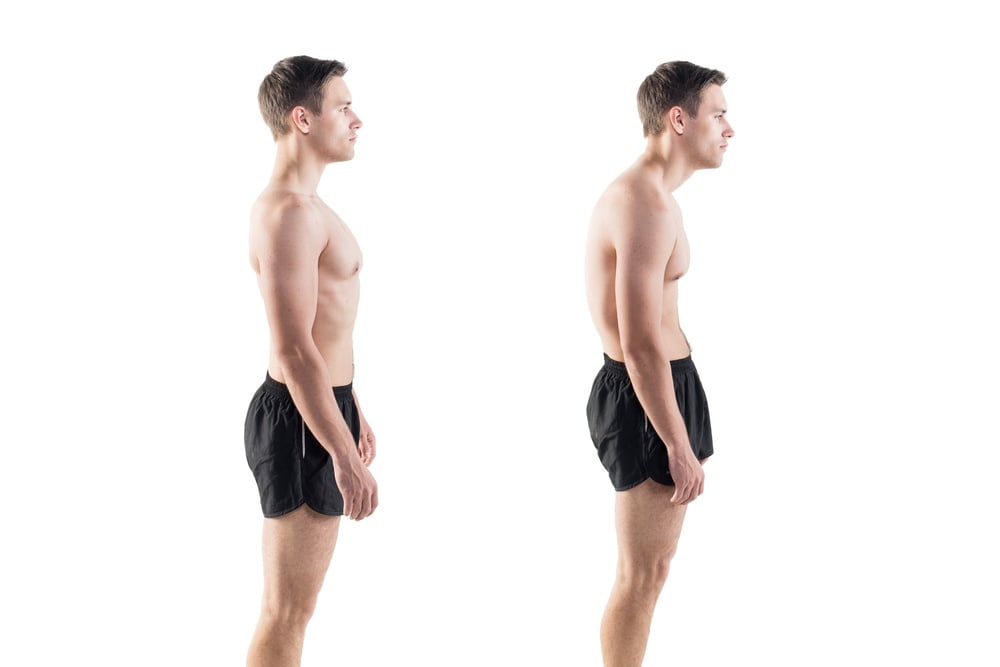
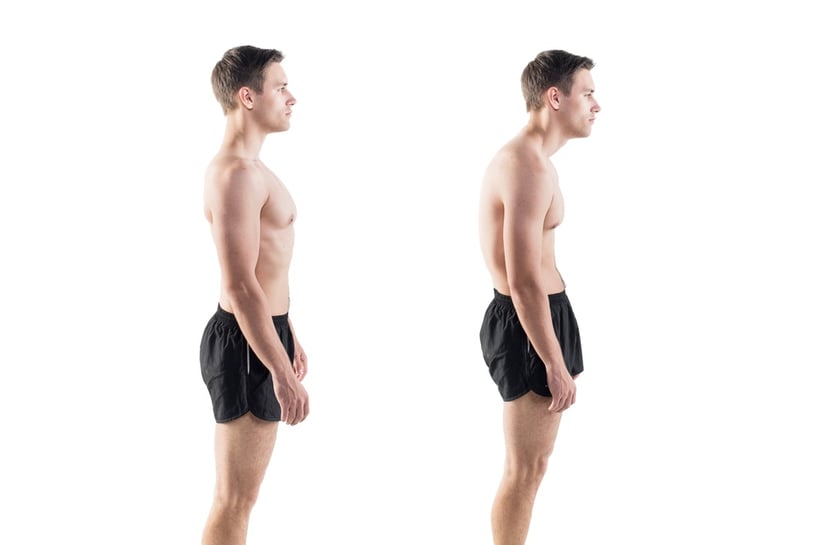
“Stand up straight,” “Sit up straight,” and “Don’t slouch!” are all excellent words of advice, and not just because correct posture helps you to look taller, thinner, and more confident. The role of posture and health in keeping proper alignment of your spine, head, and hips has a number of health benefits.
What Is Posture?
The term “posture” refers to body position: how you hold yourself when you’re standing, sitting, or lying down. In orthopedics, posture also refers to how your muscles, joints, and skeleton work together to hold you erect (upright).
Posture also includes the position of your body when you’re moving or when you carry out certain physical activities. For example:
- What’s your body’s position when you walk? How do you hold your shoulders and swing your arms? How are your hips moving? Do you lean forward or backward? How does your foot strike the ground and push off again?
- When you sit on the couch or at your work desk, what’s your usual pose? Do you cross your legs? Sit on one leg? Slouch? Crane your neck forward to read the computer screen or better see the TV?
- How do you squat or bend over to pick up something off the ground?
- Is your body symmetrical, meaning, is your alignment and are your abilities the same on both sides of your body — or are you experiencing limitations?
Orthopedists care about posture because it affects how you walk, run, and use your body. This is why they look at more than how you hold yourself when you’re sitting or standing still. They also consider your functional patterns — how you carry out regular movements such as lifting your arms, twisting at the waist, or sitting in a chair.
What Is Good Posture — And Why Does it Matter?
Good posture is straight and symmetrical. It maintains a balance so that your weight is evenly distributed throughout your body. This means different things depending on whether you’re standing, sitting, or lying down.
Standing posture
Good standing posture is neutral, meaning your core (trunk/abdomen), your head, and your pelvis are aligned vertically.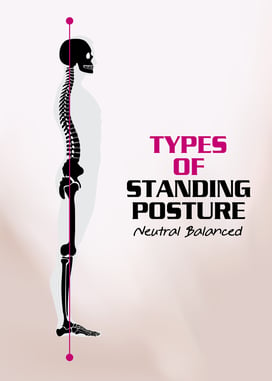
When you stand, your knees are straight and pointed forward, but they are not locked, and your weight is evenly distributed between both feet.
Your shoulders are pulled back but remain low (not up by your ears). In neutral standing posture, your chin should be raised so your head is not tilted down.
This neutral position is optimal because it allows for your muscles to contract properly when you move. Neutral posture also distributes your body weight across your skeleton so as to minimize stress on any particular joint, muscle, tendon, or ligament.
Sitting and lying down, you should also keep your posture as neutral as possible.
Sitting posture
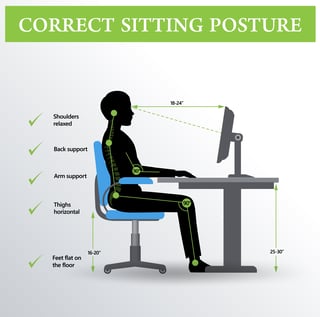 When sitting in a chair, especially a work chair when typing or using a computer, your arms and thighs should form right angles. This means your feet should be flat on the ground, and thighs and forearms should be parallel to the floor.
When sitting in a chair, especially a work chair when typing or using a computer, your arms and thighs should form right angles. This means your feet should be flat on the ground, and thighs and forearms should be parallel to the floor.
You should be sitting with a straight spine, not slumping, and your head should be in neutral position (with your chin up; not with your neck craning forward to see the computer screen).
Supportive chairs, such as ergonomically optimized desk chairs, are a good way to keep a neutral sitting posture at work.
Sleeping posture
Lying down in bed, you probably have a preference that feels comfortable to you. Most people like to sleep on their sides.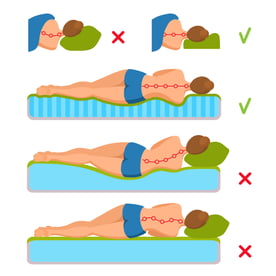 However, the National Sleep Foundation recommends sleeping on your back if you can in order to maintain a neutral spine.
However, the National Sleep Foundation recommends sleeping on your back if you can in order to maintain a neutral spine.
Whichever way you prefer to sleep, be sure to support your neck and shoulders properly with the right pillow. Elongate your body as much as you can by uncurling from the fetal position and stretching out your legs; this position is best for your spine and it prevents putting too much awkward weight or compression on any of your joints or nerves.
Why does good posture matter?
If your posture is out of alignment, your muscles need to work harder to contract. This stress can lead to soft tissue injury or excess wear and tear on your joints. These injuries become aches and pains in the short term; in the long term, they may hasten the development of degenerative osteoarthritis.
Good posture is also necessary to protect the health of internal organs like the stomach, kidneys, and GI tract. If you slump excessively, for example, your abdomen compresses, crowding your stomach and intestines and causing digestive problems like acid reflux. Good posture also allows the lungs plenty of room to expand when you breathe.
What IS Bad Posture?
Bad posture, or poor posture, is a body position that is asymmetrical or non-neutral. For example, if you have an excessively large curve in the lower back (a “swayback,” or lordosis), that is considered poor posture.
Poor posture happens when your daily activities lead to some muscles becoming tight (short) while others become weak (long). This imbalance in muscle strength can pull the body’s position askew.
Some people develop postural problems as the result of illness. However, more often, postural changes result from stress, strain, and day-to-day activities. Posture problems can be caused by:
- Weak muscles. Underdeveloped core muscles in particular can cause problems with the spine. A soft middle may make you less able to hold your trunk in alignment with your hips.
- Tight muscles. If you hold your body in the same position for too long, your muscles can shorten, pulling your posture out of alignment. Tight shoulder, neck, back, and hip muscles are very common in office workers.
- Excess body mass can affect how you move and carry yourself. (This is also true of pregnancy.) Obesity is also associated with osteoporosis (loss of bone density) in some people.
- High-heeled shoes. Wearing heels changes your gait and how you stand. Wearing heels long-term can also lead to tight calf muscles and arches.
- High-stress jobs. If you work in a stressful occupation, you may be more likely to have shoulder and neck issues. Professional drivers (of trucks and busses) are also very susceptible to posture problems due to long hours behind the wheel.
- Carrying a heavy bag. Carrying a heavy shoulder bag on one shoulder can affect your symmetry by making one shoulder higher than the other. In children, carrying overloaded backpacks can also pull shoulders back too far and strain the lower back, shoulders, and neck. Some children may lean forward at the shoulders and hips to counteract the weight, which can also lead to problems in the long-term.
Common Posture Problems
“Poor posture” isn’t just a matter of occasionally slumping in your chair or letting your shoulders sag when you stand. Over time, daily activities can actually change the curve of your spine or neck, the tilt of your hips, and the position of your head and shoulders.
A few examples of common postural issues:
- A “swayback”, is when the spine curves too far inward at the lower back. This posture can resemble an “s” when viewed from the side, with the stomach projecting forward and the buttocks projecting out.
- Rounded shoulders. This happens when tight muscles pull the shoulders forward (toward the chest). Common in office workers.
- Pushed-forward head. A forward head position is when the neck strains forward instead of staying vertical. This is also common in sedentary office workers, and can eventually lead to a hunched back.
How Bad Posture Affects Your Health
Posture matters to your health because if your body position deviates from the norm, over time you can develop problems with breathing, mobility, or balance. Poor posture may also impede your ability to grow muscle. This is a particular area of concern for children who are still growing.
Complications caused by bad posture can include:
- Balance issues. If your body is asymmetrical or your center of gravity is not squarely over your pelvis, you may be more likely to lose your balance and fall forward or backward.
- Breathing difficulty. Improper curvature of the spine and shoulders can impede the ability of your lungs to fully expand to take in (and release) oxygen. If you can’t get a full breath, you may not get enough oxygen, which can lead to a host of other issues.
- Pain, numbness, stiffness, or mobility issues. Poor posture can alter your biodynamics, reducing your range of motion and putting excess stress on nerves and joints. As a result, you may experience symptoms just about anywhere in the body:
- Feet
- Hands/fingers
- Head
- Hips
- Jaw
- Knees
- Lower back
- Neck
- Upper back
- Shoulders
- Athletes in particular may be susceptible to injuries. Poor posture throws off your biomechanics, which can lead to muscle strains, sprains, inflammation, impingement, and other injuries.
- Joint problems. Postural problems, over time, create more wear and tear on the joints. This can hasten the onset of osteoarthritis.
Over time, bad posture that isn’t corrected can have a ripple effect on the body, creating problems where there were none previously. For example, if you have one shoulder higher than the other (perhaps from carrying a heavy shoulder bag), your back muscles may work to compensate for the load. This can lead to pain and tightness in the back or neck.
Overused muscles can become toned while the other, less frequently used muscles lose strength. This can lead to imbalance, limited function, or pain. Imbalance in particular is a serious issue in older people, who may worry about losing their footing and falling.
How an Orthopedic Specialist Can Help
An orthopedist can help you by diagnosing your specific problem and prescribing a treatment to correct your posture. Posture can be improved using a variety of different methods, including:
- Tips for practicing good posture. If your issues are mild, an orthopedic physician may be able to give you a hand-out about proper posture techniques; she can also demonstrate better ways to sit or stand.
- Advice for chairs to use. Desk workers in particular may benefit from swapping out their existing chairs for options with better ergonomic support.
- Exercises or physical therapy. An orthopedist may provide you exercises to strengthen your muscles. He may also refer you to a physical therapist if needed.
- In some cases, patients may benefit from wearing specialized medical gear that can hold the spine or neck straight for a period of time. Examples of when this might be necessary include slowing the progression of juvenile scoliosis, helping to ease stress on the lower back during instances of severe low back pain, or stabilizing the spine after a surgery. An orthopedist can review the pros and cons of wearing a brace and can prescribe a fitting if necessary.
- In most cases, common posture problems can be corrected with non-surgical techniques. But some people do benefit from surgery; for example, in cases with degeneration of the vertebrae or with extreme spinal curvatures. An orthopedist can evaluate your posture and your symptoms and advise you as to whether surgery will improve your posture and provide you relief from pain and other symptoms.
Article written by: Rob Williams, MD
Dr. Williams has been practicing orthopedic surgery in Corpus Christi since 1998. After graduating from Texas Tech hereceived his medical degree from the University of Texas at San Antonio. At the prestigious Campbell Clinic located at the University of Tennessee, Dr. Williams completed not only an Orthopedic Surgery Residency, but an additional year of Fellowship Training in Spine Surgery. Dr. Williams is dedicated to creating an excellent patient experience in the office or in the surgery suite.
Topics:

